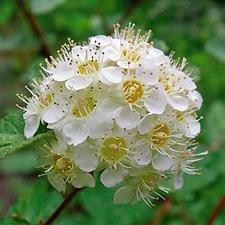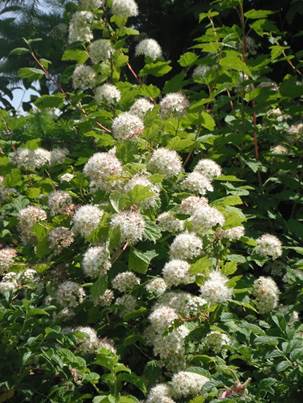…the broad leave shrub which grows something like the quill wood but has no joints, the leaf broad and deeply indented, the bark p[e]als hangs on the stem and is of a yelowish brown 〈yellow〉 colour. Meriwether Lewis, December 1, 1805, Point Adams, Oregon
Physocarpus – Greek physo – bladder and carpus – fruit, and capitatus – head-like, referring to the crowded, round flower clusters. The leaves have a distinctive maple-like look and clusters of small white flowers when in bloom. The name ninebark comes from the shreddy nature of the bark.

This is a deciduous shrub that grows up to 15 feet tall and has an upright, spreading form. It grows at lower elevation in open forests, along creeks, and in damp shrubby places often with salmonberry, red-osier dogwood, and thimbleberry. Its range extends from Alaska south to Montana and Utah, and south to California.
It was first described by the German botanist, Friedrich Pursh, who kind of fell into the opportunity to describe and publish collections from the Lewis and Clark Expedition. Lewis was tasked with this effort but either got too busy or depressed (which later led to his suicide – Lewis was having problems and most of the time after his arrival slept on the floor with his buffalo blanket) and paid Pursh the handsome sum of $70 to complete the job for him.

Before completing the effort Lewis dies and Pursh, having some fallout with his American employers, returned to Europe with a quarter of the plant collection. He published his Flora Americae Septentrionale, the first coast-to-coast vegetation description of America. Somewhat unfairly, he earned the scorn of American botanists who harbored some professional jealousy. He did take a second swing at the continent – putting together a manuscript for the vegetation of Canada, but this was lost in a fire.
Ninebark is often used in restoration plantings because unrooted cuttings as live stakes grow easily, it has a dense root system for adding stream-side stability, is rather hardy, and has a low palatability as browse for deer and elk – but provides good bird and small mammal habitat.
Native peoples used the plant in a variety of ways. The Coast Salish made tea from a stick with the outer bark peeled off as an emetic or purgative, the Cowichan made knitting needles from small twigs, and the Nuu-chah-nulth made small bows and wood items for children. The bark, however, is toxic.
This is a pretty common shrub and the wetland field survey folks don’t mind it too much because it has no thorns (yea!) but it can get pretty dense with multiple stems and can thwart one’s progress through the bush. I have a small hedgerow of native shrubs in front of my Seattle house and the ninebark did not need much tending to take off. I did notice that this year the flowers have not yet arrived given our cool and soggy spring.
